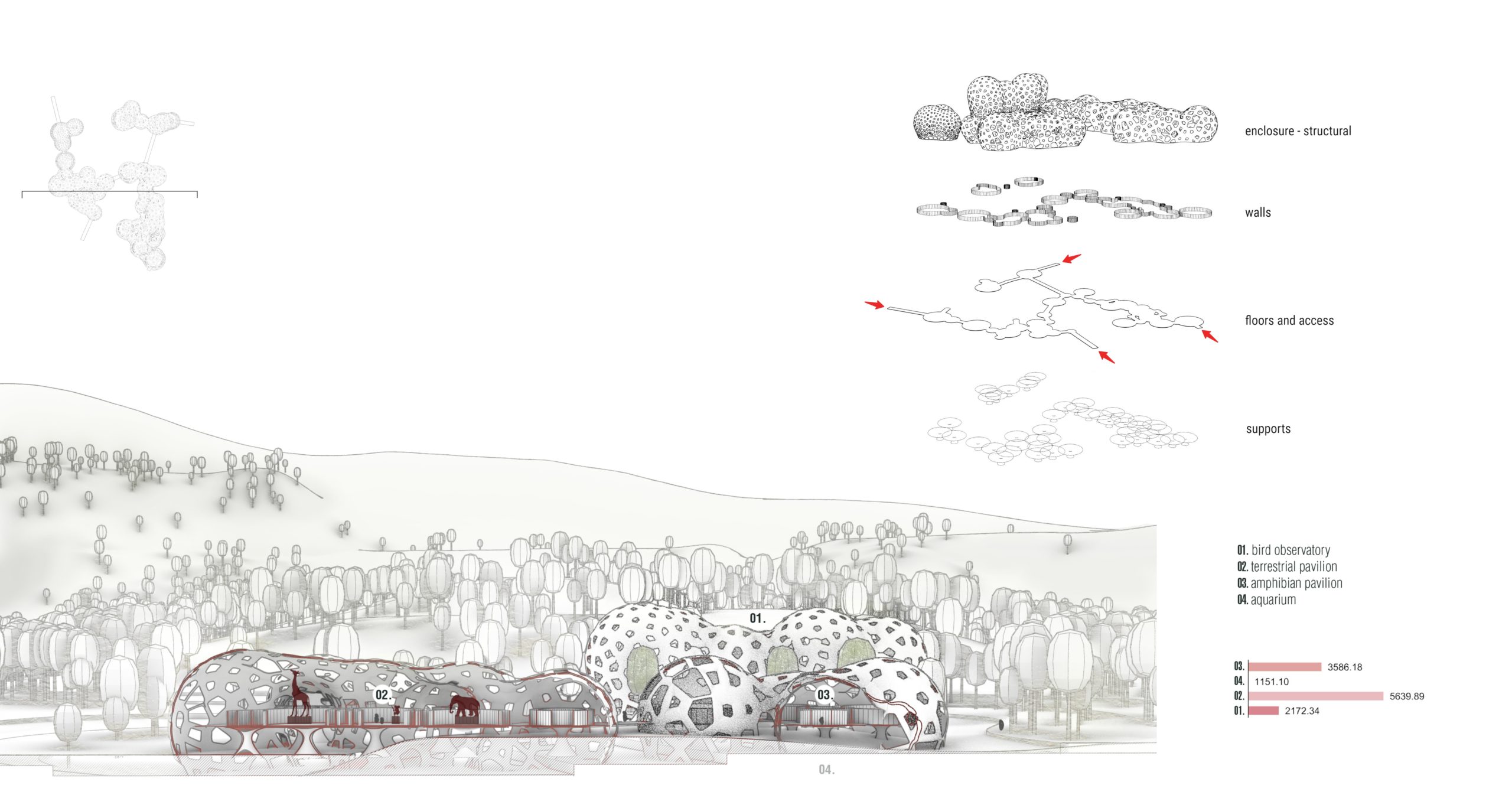Design Concept
In a world where human activities have led to the extinction of many animals and the decline of nature; the decision is made to honor these species by creating a museum where the architecture is shaped by the very essence of nature. Instead of imposing architecture on the environment, we acknowledge the fact that nature shapes us. The approach involves extracting insights from the natural world to inform architectural choices, striving to be minimally invasive in our coexistence with it.



The design approach involves extracting insights from the natural world to inform architectural choices, striving to be minimally invasive in coexistence with it. A location for the museum is sought, avoiding the necessity of cutting any trees. These surfaces are populated, and the tree’s location is used to create a distance rule, obtaining the final volumes.
AAAAAAAAAAAAAAAAAAAAAAAAAAAAAAAAAAAAAAAAAAAAAAAAAAAAAAAAAAAAAAAAAAAAAAAAAAAAAAAAAAAAAAAAAAAAAAAAAAAAAAAAAAAAAAAAAAAAAAAAAAAAAAAAAAAAAAAAAAAAAAAAAAAAAAAAAAAAAAAAAAAAAAAAAAAAAAAAAAAAAAAAAAAAAAAAAAAAAAAAAAAAAAAAAAAAAAAAAAAAAAAAAAAAAAAAAA
Pseudo Code

The design methodology consists of three main steps.
The first step is the form-finding process and results in four main volumes, for fish, terrestrial animals, amphibians, and birds. The last one is elevated to create a bird sanctuary.
The second step involves defining the aspects of the building, including skin, floors, walls, and supports. For the skin, volumes are cut, and intersection curves are extruded to the ground. The rest use the same points that generate the main volumes, creating a network of walkways and connecting circular surfaces to define the floor, walls, and internal exhibition rooms. The mesh is then trimmed with the walkway volume to create openings.
The third step which is the paneling of the mesh, a cellular aggregate structure examining voronoi geometry is chosen. The mesh face boundaries are converted to a brep to populate with points, and voronoi 3D is utilized to find points at discontinuity, scaling the center by remapping the numbers for varied size openings. The geometry is lofted to create a mesh surface from brep faces, which is then joined, thickened, and subdivided for clean quad faces, resulting in the final mesh skin.
AAAAAAAAAAAAAAAAAAAAAAAAAAAAAAAAAAAAAAAAAAAAAAAAAAAAAAAAAAAAAAAAAAAAAAAAAAAAAAAAAAAAAAAAAAAAAAAAAAAAAAAAAAAAAAAAAAAAAAAAAAAAAAAAAAAAAAAAAAAAAAAAAAAAAAAAAAAAAAAAAAAAAAAAAAAAAAAAAAAAAAAAAAAAAAAAAAAAAAAAAAAAAAAAAAAAAAAAAAAAAAAAAAAAAAAAAAAAAAAAAAAAAAAAAAAAAAAAAAAAAAAAAAAAAAAAAAAAAAAAAAAAAAAAAAAAAAAAAAAAAAAAAAAAAAAAAAAAAAAAAAAAAAAAAAAAAAAAAAAAAAAAAAAAAAA
Form Iterations

Various parameters, such as the number of points on the populated area, the distance of those points from the existing trees, the size of the spheres, and the voxelization and adaptivity of the spheres, are manipulated in iterations. This iterative process provides full control over the project and allows for the comparison of different outcomes to identify problems and potentialities among the results.
AAAAAAAAAAAAAAAAAAAAAAAAAAAAAAAAAAAAAAAAAAAAAAAAAAAAAAAAAAAAAAAAAAAAAAAAAAAAAAAAAAAAAAAAAAAAAAAAAAAAAAAAAAAAAAAAAAAAAAAAAAAAAAAAAAAAAAAAAAAAAAAAAAAAAAAAAAAAAAAAAAAAAAAAAAAAAAAAAAAAAAAAAAAAAAAAAAAAAAAAAAAAAAAAAAAAAAAAAAAAAAAAAAAAAAAAAA
Form Generation


The layout showcases how volumes organically connect with the site and merge with the context, following the rhythm of the trees. The Terrestrial Pavilion is located on the earthy surface, the amphibian is positioned between the earth and the lake, the fish is over the water, and the birds are elevated. All are interconnected with walkways and the land.
AAAAAAAAAAAAAAAAAAAAAAAAAAAAAAAAAAAAAAAAAAAAAAAAAAAAAAAAAAAAAAAAAAAAAAAAAAAAAAAAAAAAAAAAAAAAAAAAAAAAAAAAAAAAAAAAAAAAA

In the section the interaction of volumes with different ground levels is observed. The continuous floor level interacts with the variation in heights of the skin, providing the possibility of heterogeneous exhibition instances. On the right, the elements of the building are depicted, all defined using the same set of points.
AAAAAAAAAAAAAAAAAAAAAAAAAAAAAAAAAAAAAAAAAAAAAAAAAAAAAAAAAAAAAAAAAAAAAAAAAAAAAAAAAAAAAAAAAAAAAAAAAAAAAAAAAAAAAAAAAAAAAAAAAAAAAAAAAAAAAAAAAAAAAAAAAAAAAAAAAAAAAAAAAAAAAAAAAAAAAAAAAAAAAAAAAAAAAAAAAAAAAAAAAAAAAAAAAAAAAAAAAAAAAAAAAAAAAAAAAA


